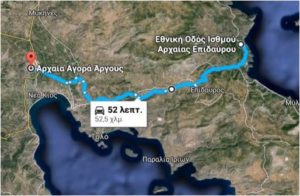The ancient Agora in Argos had already operated since the 6th century BC, in the south of the city, in a central place where all the trade routes from Heraion, Corinth and Tegea eventually converged. Its construction programme was completed at the end of the 4th century BC. Some of the most important monuments discovered include:
- A great hypostyle (pillared) hall built around 460 BC, when Argos adopted democracy, and probably functioned as a Vouleuterion (assembly house).
- Another great building, perhaps a Palestra (wrestling school), with Doric column porticoes.
- Other remnants discovered are the starting point of a Stadium (running race) route, a Nymphaeum dome and a semi-circular theater including the base of an earlier altar, perhaps one belonging to the sanctuary of Apollo Lyceus.




